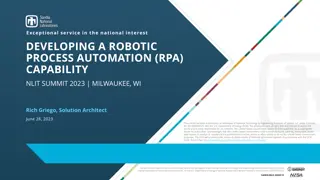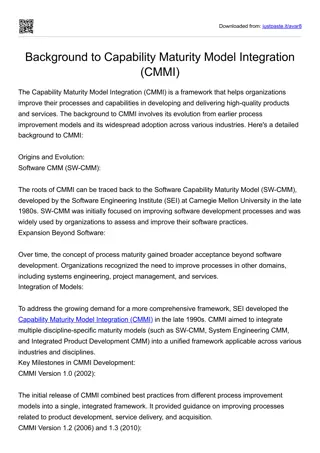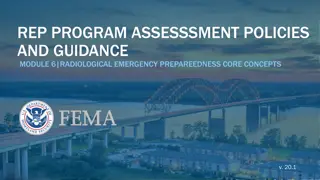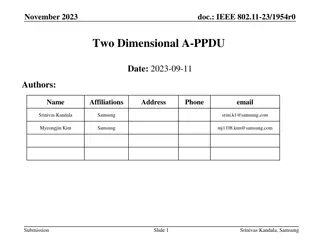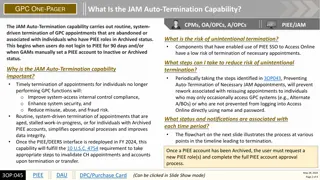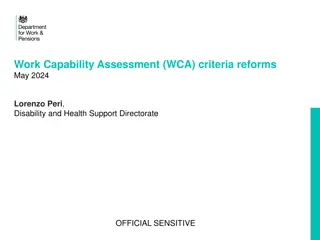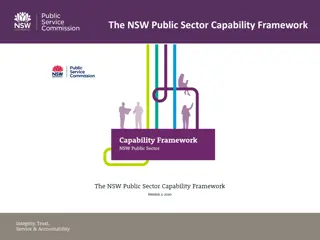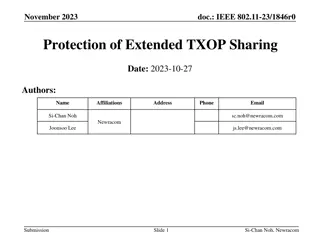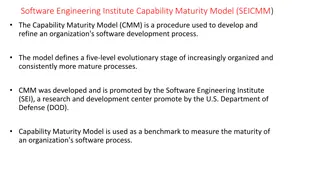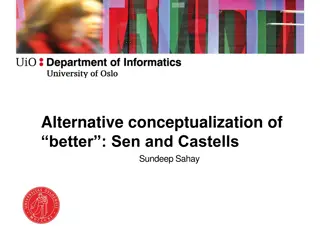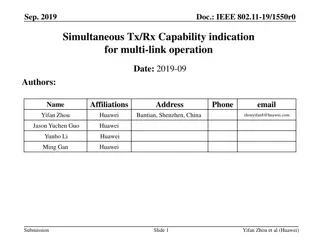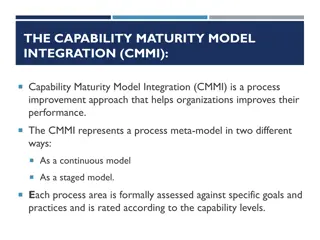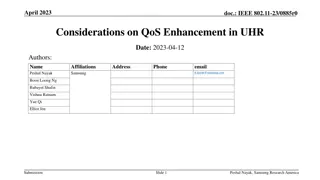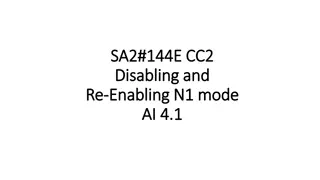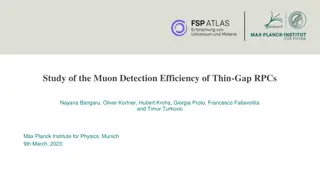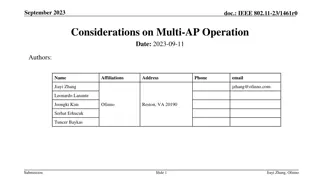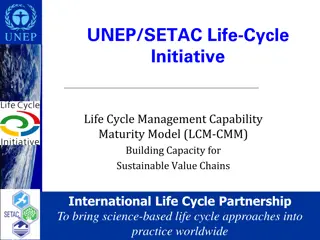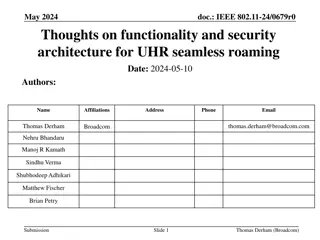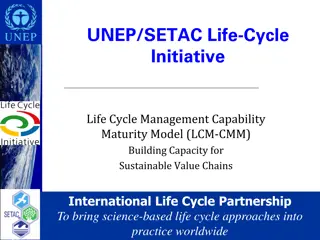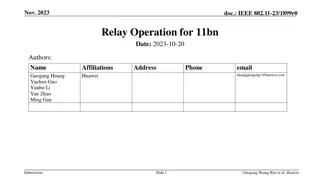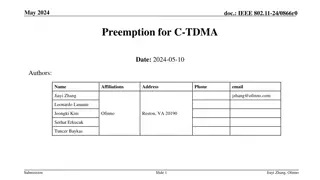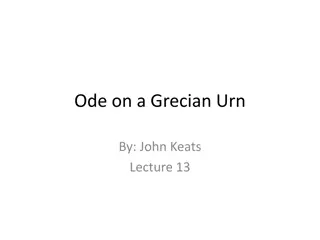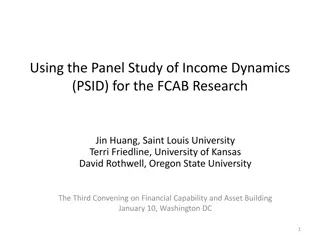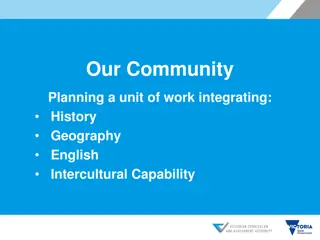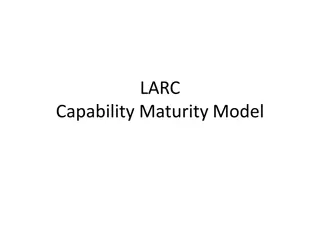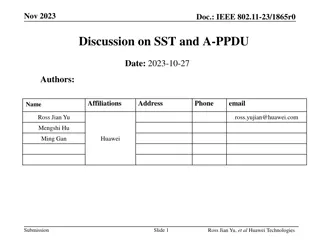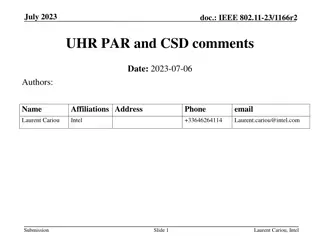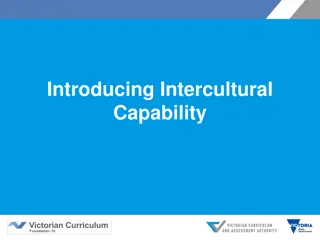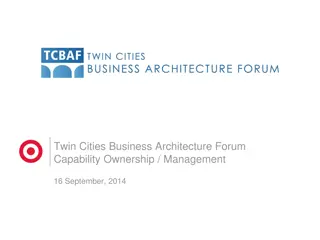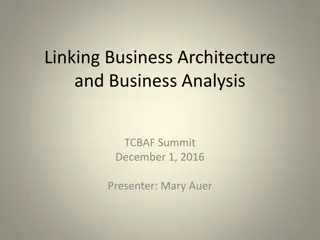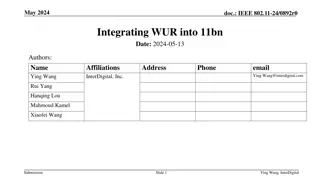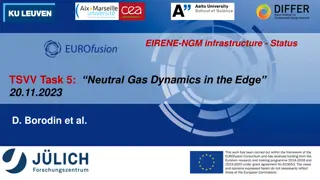NASA Navigation Sensor Technology Assessment Capability
The assessment of navigation sensor technologies for data-driven systems analysis by NASA in October 2023. Discover the motivation, method, survey, simulation model, and selected results of this capability.
0 views • 16 slides
Efficient dRU Tone Plan Design for UHR Communications
The document discusses the signaling techniques for Ultra-High Rate (UHR) communications using dRU (dense RU) for overcoming PSD limitations. It elaborates on the methods to construct a dRU tone plan and indicate dRUs within rRUs. The design involves defining different sizes of dRUs, combining tones
0 views • 28 slides
Developing Robotic Process Automation (RPA) Capability - NLIT Summit 2023 in Milwaukee, WI
This article discusses the initiative of developing Robotic Process Automation (RPA) capability in the national interest at the NLIT Summit 2023 in Milwaukee, WI. The focus is on maximizing efficiency, agility, and effectiveness by implementing RPA to automate digital tasks, reduce manual labor, and
2 views • 20 slides
Background to Capability Maturity Model Integration (CMMI)
The Capability Maturity Model Integration (CMMI) is a framework that helps organizations improve their processes and capabilities in developing and delivering high-quality products and services. The background to CMMI involves its evolution from earlier process improvement models and its widespread
0 views • 3 slides
Radiological Emergency Preparedness Program Assessment Guidance
This module covers the assessment policies and guidance for radiological emergency preparedness programs. It includes key concepts such as metrics for program evaluation, FEMA's assurance determination process, specific demonstration requirements, capability targets, and critical tasks. Participants
4 views • 22 slides
Two-Dimensional A-PPDU for Low Latency in UHR Networks
This document discusses the proposed two-dimensional (2D) A-PPDU as a solution for supporting low-latency applications in UHR networks. It delves into the details of 2D A-PPDU for downlink, focusing on the ability to insert PPDUs within a PPDU, aiming to reduce latency in UHR environments by enhanci
0 views • 17 slides
Enhanced Security Considerations in IEEE 802.11-23 for UHR
The document discusses enhanced security considerations for control frames and MAC headers in IEEE 802.11-23 addressing vulnerabilities and proposing encryption/decryption methods. It highlights the need for support for security protocols in control frames and the importance of protecting MAC header
0 views • 13 slides
JAM Auto-Termination Capability in GPC Appointments
The JAM Auto-Termination capability in GPC appointments carries out routine, system-driven termination of appointments that are abandoned or associated with individuals in Archived status. This helps improve system-access internal control compliance, enhance security, and reduce fraud risk. Steps ca
0 views • 4 slides
Work Capability Assessment (WCA) Criteria Reforms May 2024
The Work Capability Assessment (WCA) determines if individuals claiming ESA and/or UC have limited capability for work (LCW) or work-related activity. Reforms aim to better support disabled individuals to engage with work. Consultation responses highlighted the need for changes in assessing disabili
0 views • 6 slides
NSW Public Sector Capability Framework Overview
Describes core knowledge, skills, and abilities required for all NSW public sector employees across different levels and occupational groups. The framework includes five progressive capability levels and provides a shared language for effective work performance. It integrates ethical values, non-spe
3 views • 10 slides
Protection of Extended TXOP Sharing in IEEE 802.11-23/1846r0
Reusing EHT's Triggered TXOP Sharing framework for extended TXOP sharing is discussed in this document, focusing on enabling sharing APs to distribute their obtained TXOP among other BSS(s). The document explores issues related to TXOP sharing for UHR STAs when a sharing AP allocates a portion of it
0 views • 12 slides
Understanding SEICMM - Software Engineering Institute Capability Maturity Model
The SEICMM, also known as the Capability Maturity Model (CMM), is a framework developed by the Software Engineering Institute (SEI) to enhance an organization's software development process. It consists of five maturity levels to assess and improve processes, from initial ad hoc activities to optimi
0 views • 6 slides
Rethinking Development: Perspectives on Human Capability and Well-being
Explore alternative conceptualizations of development beyond economic growth, focusing on human capability and freedom. Learn about Amartya Sen's capability approach and Manuel Castells' perspective on inclusion-exclusion in the Network Society. Discover the Human Development Index, Martha Nussbaum'
0 views • 24 slides
Personal IoT Network (PIN) Terminology Discussion for 3GPP TSG-SA WG1 Meeting
In this discussion, the concept of Personal IoT Network (PIN) and its elements are explored, including the roles of PIN Elements, Configuration PIN Capability, and Gateway Capability. The necessity of gateways to the 3GPP network, device examples, and the distinction of licensed spectrum are also ad
2 views • 10 slides
IEEE 802.11-23/1980r1 Coordinated AP-assisted Medium Synchronization Recovery
This document from December 2023 discusses medium synchronization recovery leveraging multi-AP coordination for multi-link devices. It covers features such as Multi-link device (MLD), Multi-link operation (MLO), and Ultra High Reliability (UHR) capability defined in P802.11bn for improvements in rat
0 views • 8 slides
Capability Maturity Model Cascade and Viral Load Testing Stages
This content discusses the Capability Maturity Model stages, focusing on process improvement and the stages of viral load testing demand creation. It outlines the evolution from initial to optimized stages and the development towards standardized processes in organizations. Additionally, it touches
3 views • 8 slides
IEEE 802.11-19/1550r0: Simultaneous Tx/Rx Capability Indication for Multi-Link Operation
This document discusses the simultaneous Tx/Rx capability indication for multi-link operation in IEEE 802.11-19/1550r0. It covers scenarios where link selection depends on link capabilities, actions needed based on Tx/Rx capabilities, and methods to indicate simultaneous operation. The importance of
4 views • 10 slides
Understanding the Capability Maturity Model Integration (CMMI) for Process Improvement
Capability Maturity Model Integration (CMMI) is a framework that aids organizations in enhancing performance by assessing process maturity levels. It offers continuous and staged models for process improvement, with each level representing specific goals and practices. By following CMMI, organizatio
0 views • 14 slides
Enhancing Quality of Service in Ultra High Rate Wi-Fi Networks
This document explores the potential improvements in Quality of Service (QoS) for Ultra High Rate (UHR) Wi-Fi networks, focusing on the benefits of timing information sharing for traffic urgency assessment. It discusses areas such as increased reliability, lower latencies, improved manageability, an
0 views • 11 slides
Interworking Considerations for N1 Mode Capability in 5G Networks
The article discusses the implications of disabling and re-enabling N1 mode capability in UE operations when transitioning between 5G and 4G networks. It explores scenarios where session continuity may be affected and proposes solutions endorsed by industry stakeholders. Key points include the alloc
0 views • 5 slides
Approach to Equity in Climate Change by Prodipto Ghosh, Ph.D.
Prodipto Ghosh's presentation delves into the terrain of equity in climate change, emphasizing obligations of parties in mitigation, adaptation, and resource transfer. The proposed equity norms highlight cooperation, capability-based resource provisions, and ensuring low-capability individuals stay
0 views • 20 slides
Study of Muon Detection Efficiency in Thin-Gap RPCs
Conducted at the Max Planck Institute for Physics in Munich, this study focuses on the detection efficiency of thin-gap Resistive Plate Chambers. The research explores the construction, working principles, and experimental setup of RPCs, emphasizing the need for sensitive frontend electronics for hi
0 views • 14 slides
Considerations on Multi-AP Operation in IEEE 802.11-23/1461r0
This document discusses considerations for multi-AP operation within IEEE 802.11 standards, focusing on selecting transmission schemes and scheduling for optimal performance. It explores the phases involved in multi-AP setup, coordination, selection, channel sounding, data sharing, and data transmis
0 views • 12 slides
Sustainable Value Chains and Life Cycle Management Capability
The UNEP/SETAC Life-Cycle Initiative focuses on building capacity for sustainable value chains through the Life Cycle Management Capability Maturity Model (LCM-CMM). It emphasizes implementing science-based life cycle approaches globally by transitioning from events to management systems, conducting
1 views • 12 slides
UHR Seamless Roaming: Functionality and Security Architecture Proposal
Discussion on the technical requirements for UHR seamless roaming, focusing on the non-AP MLD state preservation and data exchange context between AP MLDs. Proposing a security architecture based on FT to achieve seamless roaming while cautioning against sharing PTK(SA) across multiple AP MLDs. Emph
0 views • 34 slides
Life Cycle Management for Sustainable Value Chains: Building Capacity and Promoting Innovation
This content delves into the Life Cycle Management Capability Maturity Model (LCM-CMM) aimed at enhancing sustainable value chains globally. It emphasizes the importance of bringing science-based life cycle approaches into practical implementation to address global issues, international standards, c
1 views • 11 slides
IEEE 802.11-23/1899r0 Relay Operation for 11bn - Presentation Summary
In this presentation, the IEEE 802.11-23/1899r0 document discusses relay operations to improve Rate-vs-Range (RvR) performance for UHR. Various potential solutions for implementing a relay protocol in UHR are explored, focusing on enhancing multi-hop channel access delay, end-to-end QoS, and simplif
0 views • 10 slides
Preemption Methods for Ultra High Reliability in Multi-AP C-TDMA
In this IEEE document, preemption methods are discussed for the coordinated time-division multiple-access (C-TDMA) scheme to enhance the Ultra High Reliability (UHR) capability in multi-AP operation. The focus is on reducing delays during large PPDU transmissions and improving coordination between s
0 views • 8 slides
Exploring John Keats's Negative Capability Theory in "Ode on a Grecian Urn
John Keats, known for his melancholic temperament, delved into the concept of Negative Capability in his poetry, particularly evident in "Ode on a Grecian Urn." This theory emphasizes the poet's ability to transcend rationality and immerse in intense emotions without the need for analysis or judgmen
0 views • 29 slides
Exploring Asset Accumulation and Financial Capability with PSID Data
Explore the Panel Study of Income Dynamics (PSID) data for research on financial capability and asset building. PSID is a longitudinal survey tracking households since 1968, covering various topics like wealth, savings, pensions, and more. The data allows for studying intergenerational dynamics, wea
0 views • 5 slides
Integrating History, Geography, English & Intercultural Capability in Community Planning
Exploring how to plan a unit of work integrating History, Geography, English, and Intercultural Capability based on the Victorian Curriculum. The unit, "Our Community," spans five weeks and focuses on continuity and change in the local community, significant places, people, and events, and interacti
0 views • 15 slides
Understanding the LARC Capability Maturity Model for Organizational Improvement
The LARC Capability Maturity Model (CMM) focuses on enhancing the viral load cascade, aiming to achieve better patient outcomes and improve institutional capabilities for viral load scale-up. Developed by Carnegie-Mellon University Software Engineering Institute in 1987, the CMM provides a structure
0 views • 14 slides
Discussion on IEEE 802.11-23/1865r0: SST and A-PPDU
The document discusses the current lack of support for SST on S160 in 11be, highlighting that 11be AP and STA do not support A-PPDU. It explores potential combinations for A-PPDU involving UHR and non-UHR HE and EHT STAs, addressing bandwidth enhancements and benefits of various scenarios. The analy
0 views • 14 slides
IEEE 802.11-23 UHR PAR and CSD Comments Review
Reviewing comments and responses on IEEE 802.11-23/1166r2 UHR PAR and CSD focusing on enhancing Ultra High Reliability in Wireless Local Area Networks (WLAN) with clarifications and modifications for project scope and objectives.
0 views • 21 slides
Enhancing Intercultural Capability in Victorian Curriculum
Victorian Curriculum F-10, released in 2015, emphasizes intercultural capability to develop students' awareness, respect, and skills in cultural diversity. It aims to foster understanding of different cultures, challenge stereotypes, and promote acceptance for a cohesive community. The curriculum st
0 views • 5 slides
Business Capability Ownership Roles and Responsibilities at Target
Explore the journey of developing business capabilities at Target, focusing on ownership roles such as Business Capability Owner, Leader/Manager, Steward, and Stakeholder. Learn how clarity, participation, and executive involvement are essential for successful capability framework creation and utili
0 views • 7 slides
The Connection Between Business Architecture and Business Analysis
Exploring the link between business architecture and business analysis, this presentation delves into the challenges faced by business architects in keeping enablers up to date, establishing a common language, identifying stakeholders, and ensuring traceability. The objective is to facilitate inform
0 views • 17 slides
Integrating WUR into IEEE 802.11bn for Enhanced Network Efficiency
IEEE 802.11-24/0892r0 proposes integrating Wake-Up Radio (WUR) technology into 11bn networks to improve reliability, support low latency traffic, increase peak throughput, and enhance power-saving capabilities. The WUR acts as a companion radio to the main connectivity radio, enabling power-saving w
0 views • 10 slides
Preamble and PE Transmission in PPDU Using DRU
The document discusses the transmission of Preamble and Physical End with the DRU technology in PPDU for IEEE 802.11 networks. It covers various aspects such as legacy preamble, UHR-STF, UHR-LTF, PE fields, and SIG transmission. The focus is on achieving compatibility and performance efficiency in D
0 views • 13 slides
Development of EIRENE-NGM for Neutral Gas Dynamics in Fusion Reactors
EIRENE-NGM project focuses on enhancing the neutral gas dynamics model for fusion reactor simulations, including efficient HPC utilization, physics basis refinement, database improvement, interface development, and predictive capability validation. Collaborators from various institutes aim to create
0 views • 17 slides


